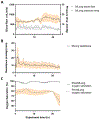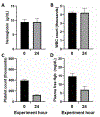A pumpless artificial lung without systemic anticoagulation: The Nitric Oxide Surface Anticoagulation system
- PMID: 34649727
- PMCID: PMC8810669
- DOI: 10.1016/j.jpedsurg.2021.09.015
A pumpless artificial lung without systemic anticoagulation: The Nitric Oxide Surface Anticoagulation system
Abstract
Background: Artificial lungs have the potential to serve as a bridge to transplantation or recovery for children with end-stage lung disease dependent on extracorporeal life support, but such devices currently require systemic anticoagulation. We describe our experience using the novel Nitric Oxide (NO) Surface Anticoagulation (NOSA) system-an NO-releasing circuit with NO in the sweep gas-with the Pediatric MLung-a low-resistance, pumpless artificial lung.
Methods: NO flux testing: MLungs (n = 4) were tested using veno-venous extracorporeal life support in a sheep under anesthesia with blood flow set to 0.5 and 1 L/min and sweep gas blended with 100 ppm NO at 1, 2, and 4 L/min. NO and NO2 were measured in the sweep and exhaust gas to calculate NO flux across the MLung membrane. Pumpless implants: Sheep (20-100 kg, n = 3) underwent thoracotomy and cannulation via the pulmonary artery (device inflow) and left atrium (device outflow) using cannulae and circuit components coated with an NO donor (diazeniumdiolated dibutylhexanediamine; DBHD-N2O2) and argatroban. Animals were connected to the MLung with 100 ppm NO in the sweep gas under anesthesia for 24 h with no systemic anticoagulation after cannulation.
Results: NO flux testing: NO flux averaged 3.4 ± 1.0 flux units (x10-10 mol/cm2/min) (human vascular endothelium: 0.5-4 flux units). Pumpless implants: 3 sheep survived 24 h with patent circuits. MLung blood flow was 716 ± 227 mL/min. Outlet oxygen saturation was 98.3 ± 2.6%. Activated clotting time was 151±24 s. Platelet count declined from 334,333 ± 112,225 to 123,667 ± 7,637 over 24 h. Plasma free hemoglobin and leukocyte and platelet activation did not significantly change.
Conclusions: The NOSA system provides NO flux across a gas-exchange membrane of a pumpless artificial lung at a similar rate as native vascular endothelium and achieves effective local anticoagulation of an artificial lung circuit for 24 h.
Keywords: Artificial lung; Biocompatibility; Extracorporeal life support; Extracorporeal membrane oxygenation; Non-thrombogenic circuits; Pediatric respiratory failure.
Copyright © 2021 Elsevier Inc. All rights reserved.
Figures







References
-
- Extracorporeal Life Support Organization International Summary. 2020.
-
- Hoganson DM, Gazit AZ, Boston US, Sweet SC, Grady RM, Huddleston CB, et al. Paracorporeal lung assist devices as a bridge to recovery or lung transplantation in neonates and young children. J Thorac Cardiovasc Surg 2014;147(1):420–7. - PubMed
-
- Strueber M, Hoeper MM, Fischer S, Cypel M, Warnecke G, Gottlieb J, et al. Bridge to Thoracic Organ Transplantation in Patients with Pulmonary Arterial Hypertension Using a Pumpless Lung Assist Device. Am J Transplant 2009;9(4):853–7. - PubMed
-
- Lorusso R, De Cicco G, Totaro P, Gelsomino S. Effects of phosphorylcholine coating on extracorporeal circulation management and postoperative outcome: a double-blind randomized study. Interact Cardiovasc Thorac Surg 2008;8(1):7–11. - PubMed
MeSH terms
Substances
Grants and funding
LinkOut - more resources
Full Text Sources

